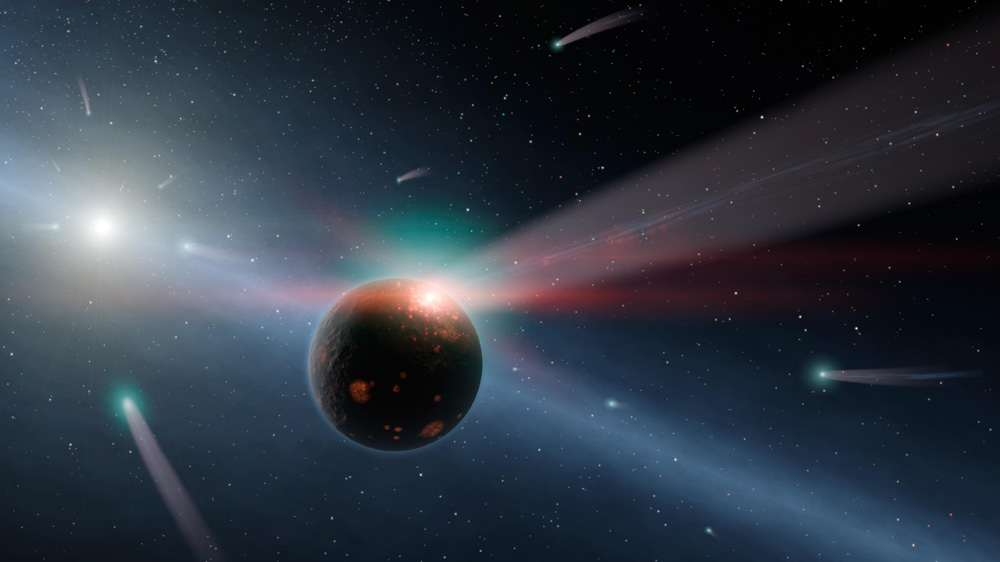It is now generally accepted that the planets in our solar system formed via the accumulation of smaller bodies dubbed “planetesimals” – which in turn formed from the accumulation of dust grains and (in the outer and thus colder regions) gas molecules – early in its history. Due to the early sun’s rotation the infalling material from the original cloud of gas and dust from which the sun formed would have been spun out into a relatively flat disk surrounding the sun, and thus the planets formed more-or-less in or at least near the plane of the sun’s equator. Meanwhile, the asteroids and comets that we see today are the “leftovers” from the planet formation process, and the occasional impacts that take place serve to remind us that this process is still ongoing (albeit at a much lower level than early in the solar system’s history). This entire process is discussed in more detail in a future “Special Topics” presentation.
It would seem reasonable to suppose that the same processes would take place in the formation of other planetary systems. At this time well over 3000 planets have been confirmed orbiting around other stars – the vast majority of these having been detected by the Kepler Space Telescope that was launched in 2009 – and it is now quite apparent that planetary systems are indeed commonplace in the Galaxy (and, by extension, the universe as a whole), although it is also quite apparent that not only is our solar system not a “typical” planetary system, there really is no such thing as a “typical” planetary system.
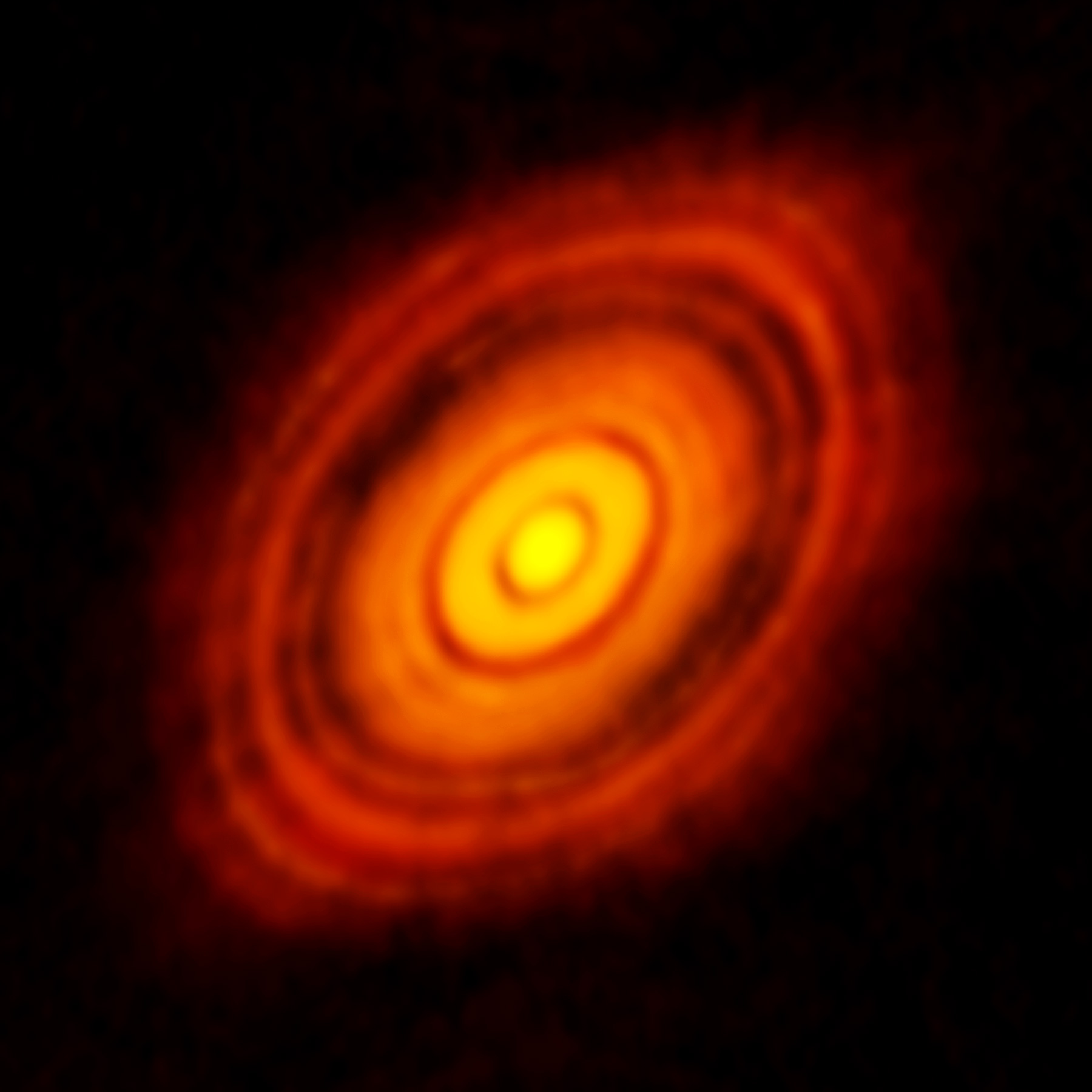
We would accordingly expect that young stars would be accompanied by disks of material that is currently in the act of forming planets. One of the earlier indications of this was the detection in 1975 by University of California astronomer Martin Cohen, who detected the infrared signature of the likely strong presence of water ice surrounding the young solar-type star HL Tauri (which is only about one million years old). The presence of a gas disk around HL Tauri was firmly detected at radio wavelengths by Annelia Sargent and Steve Beckwith in the mid-1980s, and has been imaged recently by the Atacama Large Millimeter/submillimeter Array (ALMA) telescope in Chile.
In 1983 the InfraRed Astronomical Satellite (IRAS) spacecraft detected excesses of infrared radiation, indicative of accompanying dust disks, around several stars, including the bright naked-eye stars Vega and Fomalhaut as well as the 4th-magnitude star Beta Pictoris. Begin in the mid-1990s the Hubble Space Telescope began directly detecting “proto-planetary disks” around young stars in the Orion Nebula region and elsewhere, and as of now planet-forming disks have been found around many young stars – including some with planets that have already formed – confirming the overall current consensus of the planet formation process.
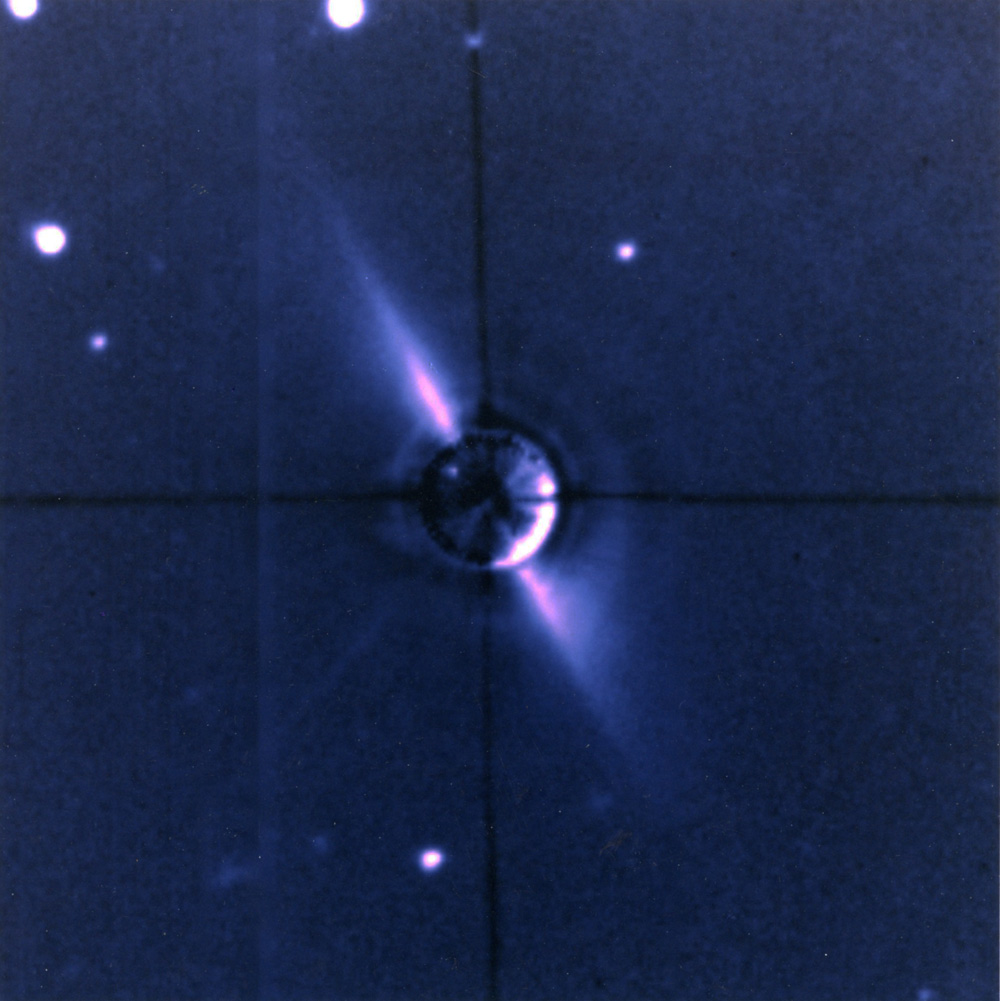
The disk around Beta Pictoris, in particular, has been intensely studied ever since it was first reported. Following the IRAS report of excess infrared radiation, in 1984 Brad Smith and Richard Terrile optically imaged the disk with the 2.5-meter du Pont telescope (and an accompanying coronagraph) at the Las Campanas Observatory in Chile, finding it to be oriented almost exactly edge-on to us. Various studies over the years have shown that the disk is warped in places, suggesting the presence of planets, and in 2008 the presence of a planet roughly two to four times the size of Jupiter was detected orbiting the star at an approximate distance of 9 AU.
In the mid-1980s a team of French astronomers, including Roger Ferlet, Anne-Marie Lagrange (who would make the discovery of Beta Pictoris’ planet two decades later), and Alfred Vidal-Madjar reported spectroscopic observations of Beta Pictoris which indicated the presence of material falling onto the star, which they interpreted as being potentially due to comets. Similar phenomena have now been detected around a handful of other stars, including the 4th-magnitude star Eta Corvi, and meanwhile excess emission of carbon monoxide around the 6th-magnitude star 49 Ceti has been interpreted as being due to the presence of large numbers of comets in what would be that star’s equivalent of the Kuiper Belt. More recently, observations obtained by ALMA – while it was still under construction – have revealed a large region in that star’s surrounding disk where objects, including comets, are forming and growing.
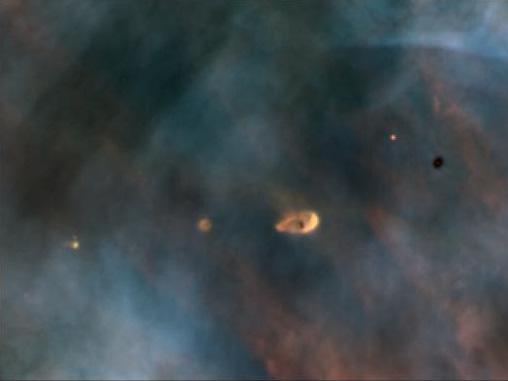
Almost all of the known examples of these putative exocomet populations are young stars of early spectral type (mostly A-type, although Eta Corvi is an F-type star), however in 2001 a team led by Gary Melnick detected evidence of potential comets around the old, evolved star CW Leonis. In late 2003 astronomers Matthew Povich and John Raymond (at the Harvard-Smithsonian Center for Astrophysics) combined the available information for the potential exocomets known at that time (including those around CW Leonis) with information collected by instruments aboard the SOlar and Heliospheric Observatory (SOHO) of Comet Kudo-Fujikawa C/2002 X5 that had passed perihelion close to the sun early that year, and concluded that comets likely exist around almost all stars and play the same role in planet formation that they do in our solar system. (Incidentally, I along with my then-10-year-old son Tyler provided some of the early astrometric observations that were utilized in determining the orbit of Comet Kudo-Fujikawa.)
Although all of this evidence is interesting and indicates the very likely existence of exocomets, it nevertheless remains circumstantial. In March 2019, however, a team of astronomers led by Sebastian Zieba and Konstanze Zwintz of the University of Innsbruck in Austria announced that in four months worth of photometric data taken by the recently-launched Transiting Exoplanet Survey Satellite (TESS) mission they had detected three drops in brightness that were consistent with the transits of exocomets across the disk of Beta Pictoris. The strongest of these brightness drops, which began on January 2, 2019, lasted two days and exhibited a behavior consistent with “an evaporating comet with an extended tail.” These observations constitute the first confirmed detections of exocomets.
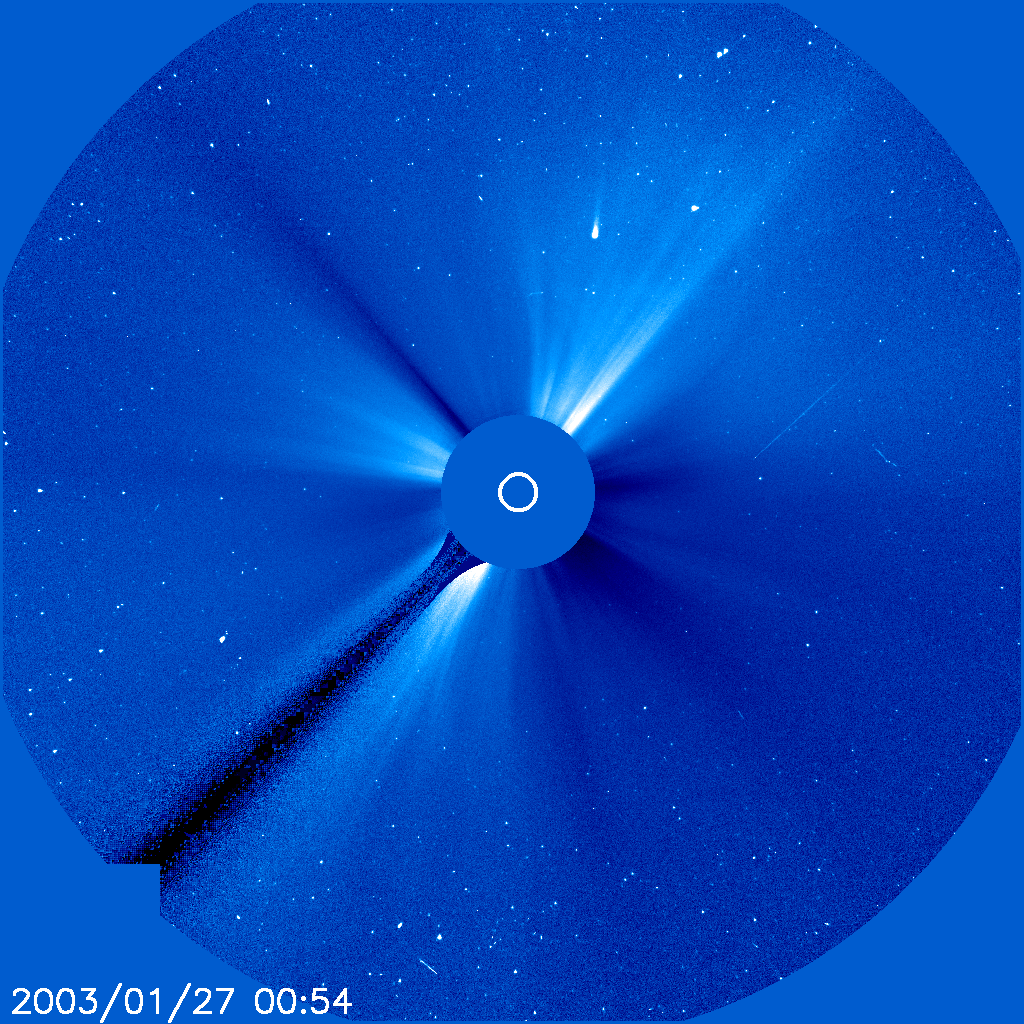
It would appear, then, that comets – and, one would think, asteroids – form and build planets in other planetary systems just like in our solar system, and that the existence of exocomets (and “exoasteroids”) is ubiquitous throughout the Galaxy. Meanwhile, disks of material, which can perhaps be interpreted as being analogous to structures like the asteroid belt and Kuiper Belt in our solar system, have now been detected around many other stars. One nearby example is Epsilon Eridani, one of the closest sun-like stars to our solar system (being at a distance of 10.5 light-years); at least two such disks, one at approximately 3 AU from the star and the other at 20 AU, have been detected.
Since numerous comets would have been ejected from the solar system during the formation of the planets, and, as a result of gravitational perturbations from those planets, afterwards – a process that continues today – it would seem reasonable to think that comets would have been ejected from other planetary systems as well and are roaming interstellar space. Every once in a while one or more of these “interstellar comets” would accordingly be expected to pass through our solar system. The apparent first-known such object, named ‘Oumuamua, was discovered in October 2017, and is featured in a future “Special Topics” presentation, while the second, and most recently-discovered, interstellar object, Comet 2I/Borisov, is currently detectable with large telescopes from the southern hemisphere and is a future “Comet of the Week.”
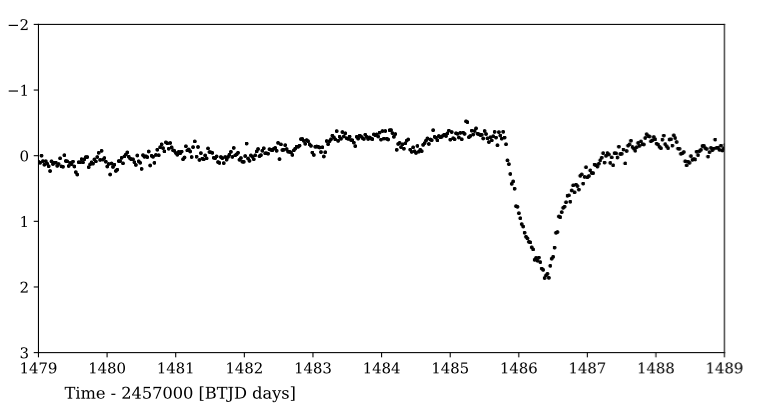
An interesting variation of the subject of exocomets is provided by a 12th-magnitude star in Cygnus officially designated KIC 8462852 (the “KIC” standing for “Kepler Input Catalog”) and informally known as “Boyajian’s Star.” It is located approximately 1470 light-years away and was one of the stars routinely examined by the Kepler Space Telescope while it was operational between 2009 and 2013. Kepler’s primary mission was to examine stars for regular and periodic tiny drops in brightness that would be indicative of orbiting planets, but in the case of this star Kepler detected significantly large drops in brightness that occurred at irregular intervals, varied dramatically in strength, and lasted much longer – in one case, for as long as two months. An analysis of archived images of the star dating back to 1890 suggests that it has faded by as much as 15% during the intervening decades.
A team of astronomers that included several “citizen scientists” and led by Tabitha Boyajian (then at Yale University) announced their discovery of these light variations in a paper posted as a preprint in September 2015 and formally published (in the Monthly Notices of the Royal Astronomical Society) in late January 2016. The announcement became public with quite a bit of fanfare in October 2015 and was accompanied by a wide range of speculations concerning possible causes of the star’s seemingly inexplicable behavior. The potential explanation that received the most public attention involved “alien megastructures,” i.e., all or portions of a hypothetical “Dyson Sphere,” although the explanation that the researchers considered most likely invoked a large swarm of disintegrating comets – perhaps gravitationally distorted by a nearby M-dwarf star.
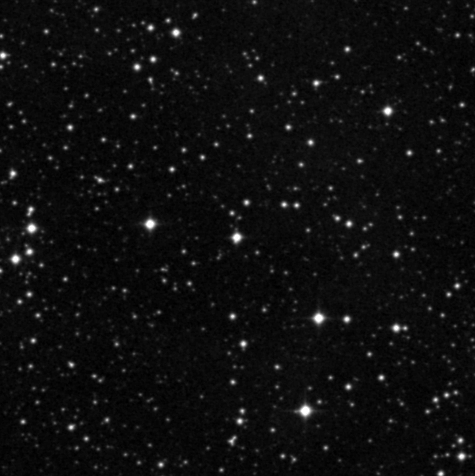
Boyajian’s Star has continued to exhibit significant and irregular changes in brightness since the original announcement, including as recently as September 2019, and it continues to be monitored. As for the potential explanations, SETI searches for radio signals have been unsuccessful – not that the “alien megastructures” possibility was ever considered to be very likely in the first place. The “swarm of comets” possibility does have some difficulties – the existence of a comet cloud large and dense enough to cause the observed brightness drops being among them – but still remains a viable possibility. Similar explanations, for example, a large planet accompanied by one or more large populations of Trojan asteroids – a subject that will be discussed in a future “Special Topics” presentation – also remain viable. On the other hand, it is possible that intrinsic changes in the star’s interior are responsible for the brightness variations. For now, there is no firm explanation for what is causing Boyajian’s Star to exhibit the behavior we are seeing – but the resolution of such mysteries is why we conduct science in the first place.
Indeed, just a few months ago retired University of Nebraska-Lincoln astronomer Edward Schmidt published the results of his study wherein he has identified as many as 21 potential analogs of Boyajian’s Star. Some of these are one solar-mass stars similar to our sun, others are stars of two solar masses that are in or near the “red giant” phase of stellar evolution; meanwhile, some of these have drops in brightness with the approximate frequency that Boyajian’s Star experiences, while others do so more rapidly. Whether or not these stars are exhibiting the same phenomena as Boyajian’s Star, or there are other unknown explanations for their respective behaviors, remains to be determined.
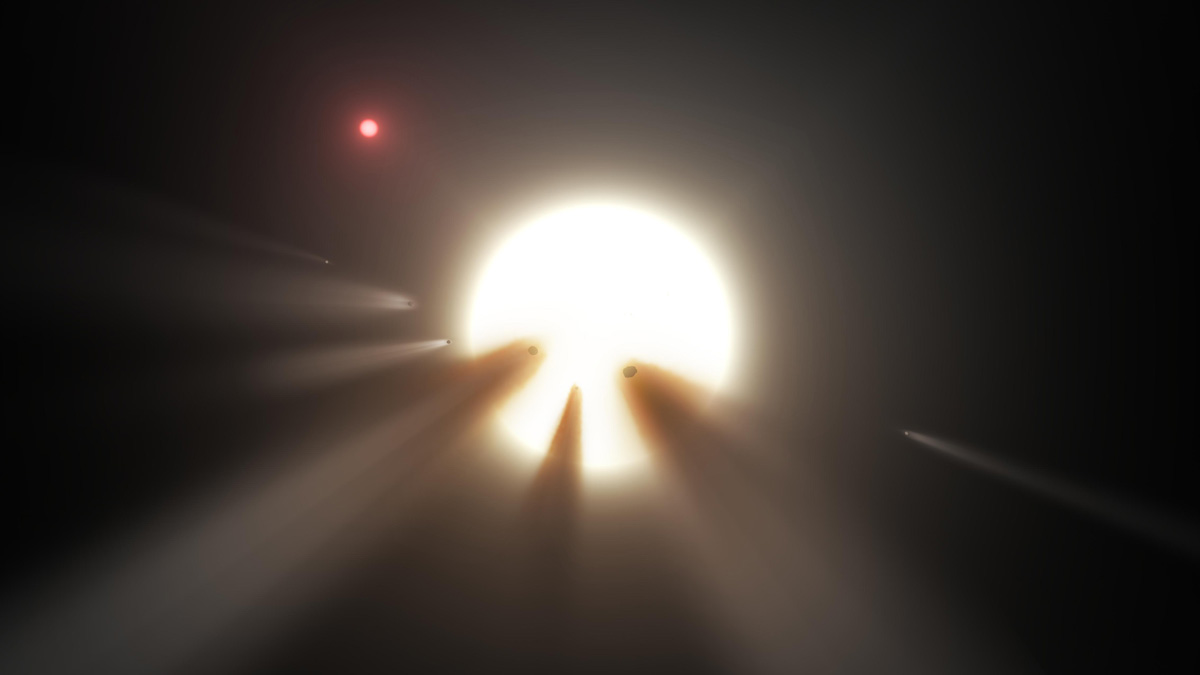
More from Week 5:
This Week in History Comet of the Week Free PDF Download Glossary
Ice and Stone 2020 Home Page
